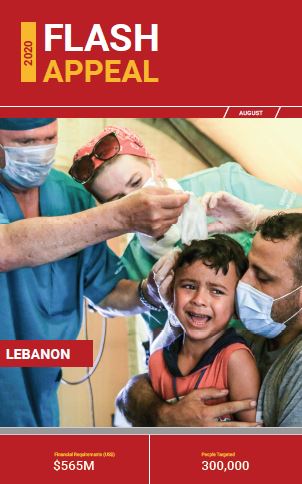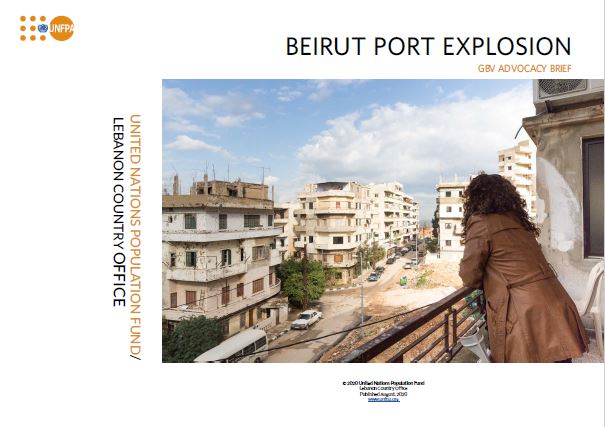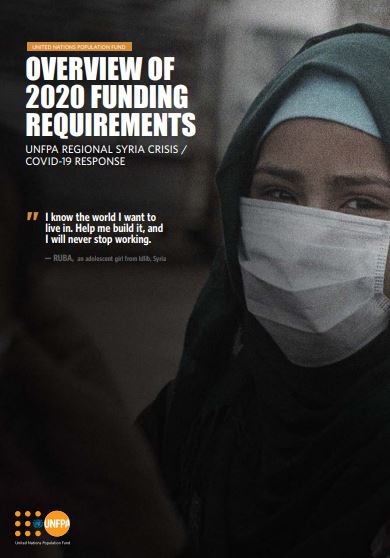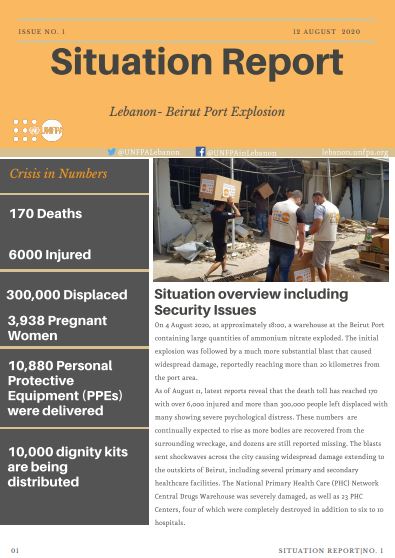You are here
New Releases

Beirut Explosion Situation Report No.2
On 4 August 2020, at approximately 18:00, a warehouse at the Beirut Port containing large quantities of ammonium nitrate exploded. The initial explosion was followed by a much more substantial blast that caused widespread damage, reportedly reaching more than 20 kilometres from the port area.
As of 18 August, reports indicate that the death toll has reached 220, with over 7,000 injured and more than 300,000 people left displaced, with many showing symptoms of severe psychological distress. These numbers are expected to rise as more bodies are recovered from the surrounding wreckage and dozens of people are still reported missing. The situation is further exacerbated by rising confirmed cases of COVID-19.
The World Health Organization (WHO) reports that more than 80 primary health care centres have been severely damaged. Only 47 per cent of surveyed facilities can still provide full routine health services. Moreover, 120 schools, attended by 55,000 children, sustained various levels of damage. Humanitarian partners are conducting further damage assessments, in close coordination with relevant government authorities. Rising cases of COVID-19 are exacerbating the situation. On 19 August, 589 new confirmed cases were reported, adding to the cumulative 10,347 confirmed cases, averaging around 5 percent daily increase since the blast.
The Beirut Port, which processes up to 90 per cent of Lebanon’s imports, is expected to remain inoperable for at least one month, pending repairs, debris removal, and safety clearances. This may exacerbate food insecurity, which was already growing amid the COVID-19 pandemic and the prolonged socio-economic crisis. All trade activities have been redirected to the Tripoli Port, located about 85 kilometres north of Beirut.

Lebanon UN Flash Appeal
The Beirut Port explosions on 4 August created significant immediate humanitarian needs and severe long-term consequences. Building on existing humanitarian response efforts, a comprehensive, effective response to this emergency requires three phases of activity. Such a plan should quickly transition from immediate humanitarian relief into recovery, reconstruction and eventually longer-term economic recovery. This humanitarian Flash Appeal focuses on the first phase and the early parts of the second phases of the response, and the activities covered will save lives, protect the most vulnerable and set the stage for subsequent longer term reconstruction and economic recovery, which constitutes a third phase.
The first phase will prioritize life-saving responses and protection. These activities continue alongside the pre-existing humanitarian response for the Lebanese and non-Lebanese population, including Syrian and Palestine refugees and migrants.
The second phase will deliver recovery and reconstruction interventions to restore public infrastructure, rehabilitate private homes and stabilize the wider situation. Some recovery responses which must be implemented with no delays alongside life-saving
activities in order to prevent a rapid growth in humanitarian needs are included in the Flash Appeal.
Although third phase interventions are not included in this immediate humanitarian Flash Appeal, the international community must support these efforts. Economic recovery remains crucial and would constitute a final part of a comprehensive response.

Beirut GBV Advocacy Brief
On 4 August, 2020, at approximately 18h00 (local time), a warehouse at the Beirut Port containing large quantities of ammonium nitrate exploded. The initial explosion was followed by a much more substantial blast that caused widespread damage reportedly reaching more than 20 kilometres from the port area. The incident has created yet another large-scale crisis in a country that is in the midst of a serious economic crisis as well as the COVID-19 pandemic.
Gender-based violence (GBV) is among the greatest protection challenges within any humanitarian crisis, disproportionately affecting women and girls and impacting families and communities at large. In the aftermath of the Beirut explosion, the compounded situation will only stand to multiply those risks significantly, further impacting the lives and safety of women and girls at home and at various public spaces, diminishing means of protection, undermining the resilience of communities and society as a whole, and impeding recovery and rebuilding efforts. In this respect, the continuous support to ensure that GBV response services remain available and accessible to women and girls is of paramount importance, together with reducing GBV risks in all sectors throughout the response.
This document provides a number of recommendations to achieve this, which are intended for all stakeholders working towards meeting the immediate and long-term needs of impacted community segments.

Beirut GBV Advocacy Brief
On 4 August, 2020, at approximately 18h00 (local time), a warehouse at the Beirut Port containing large quantities of ammonium nitrate exploded. The initial explosion was followed by a much more substantial blast that caused widespread damage reportedly reaching more than 20 kilometres from the port area. The incident has created yet another large-scale crisis in a country that is in the midst of a serious economic crisis as well as the COVID-19 pandemic.
Gender-based violence (GBV) is among the greatest protection challenges within any humanitarian crisis, disproportionately affecting women and girls and impacting families and communities at large. In the aftermath of the Beirut explosion, the compounded situation will only stand to multiply those risks significantly, further impacting the lives and safety of women and girls at home and at various public spaces, diminishing means of protection, undermining the resilience of communities and society as a whole, and impeding recovery and rebuilding efforts. In this respect, the continuous support to ensure that GBV response services remain available and accessible to women and girls is of paramount importance, together with reducing GBV risks in all sectors throughout the response.
This document provides a number of recommendations to achieve this, which are intended for all stakeholders working towards meeting the immediate and long-term needs of impacted community segments.

UNFPA Regional Syria Crisis / COVID-19 Response: Overview of 2020 Funding Requirements
The crisis in Syria has been globally recognised as one of the worst humanitarian crises of our time. As of 2020, more than 11.7 million people inside Syria are in need, while close to 5.7 million have taken refuge in neighbouring countries throughout the region. Since 2011, UNFPA has been responding to the needs of Syrian women and girls, delivering an integrated package of sexual and reproductive health (SRH) and gender-based violence (GBV) services that meet the continually evolving needs on the ground.
This funding overview provides a snapshot of UNFPA's needs during 2020, including those required to continue delivering life-saving SRH and GBV services as well as funds needed to support UNFPA's COVID-19 response within the context of the Syria crisis.

Brussels IV Conference on Supporting the Future of Syria and the Region: Position Paper
Nearly ten years into the crisis, a variety of factors have placed women and girls at increased risks of GBV and in increased need of related services, including SRH. These include multiple displacements, negative coping mechanisms, change of gender roles within the families, growing tensions with host communities and the now worsening socio-economic situation. Meanwhile, evidence shows that the COVID-19 pandemic has further exacerbated the risks of GBV and increased the needs faced by women and girls and impacted their access to life-saving services.
In the lead-up to the Brussels IV conference on supporting Syria and the region, this position paper provides an overview of the evolution of programmes in Syria and the region, highlighting best practices and providing recommendations for the way forward.

UNFPA Supplies Annual Report 2019
UNFPA Supplies, a United Nations Population Fund thematic fund, is the only United Nations programme dedicated to family planning, and it is the world’s largest provider of donated contraceptives. UNFPA Supplies supports countries with the greatest needs, helping them to strengthen their supply chains so that women and adolescent girls can access a choice of contraceptives no matter where they live. The programme has a particular focus on 46 countries, in addition to providing support for reproductive health services in humanitarian crises.
Highlights of Key Progress in 2019 is an overview of key UNFPA Supplies work in 2019 around the themes of expanding contraceptive method choice, strengthening supply chains and securing sustainable financing. Select examples from countries illustrate the programme’s support.
The second section of the report, Reporting on the Performance Monitoring Framework, is a detailed report of progress against the programme framework, including a scorecard for at-a-glance information and a detailed financial report.

H6 Joint Programme Report (2012-2019)- Delivering health results for women, children and adolescents everywhere
T
he SDG agenda and the Global Strategy for Women, Children and Adolescents Health call upon UN Member States and their partners to deliver on ambitious outcomes by 2030. This includes the unfinished Survive agenda as well as the Thrive and Transform agenda. Every Woman Every Child is an unprecedented global movement that mobilizes and intensifies both international and national action by governments, multilaterals, the private sector and civil society to address the major health challenges facing women, children and adolescents around the world.
Since 2008, UNICEF, UNFPA, World Bank and WHO have joined forces under the H4 and later, in 2016, together with UNAIDS and UN Women, formed the H6 Partnership.The purpose of the H6 is to leverage the collective strengths, comparative advantages, and capacities of each of its six-member organizations in order to support countries with high burdens of maternal, neonatal, child and adolescent mortality and morbidity in their efforts to improve the survival, health and well-being of every woman, newborn, child and adolescent.
The SDG agenda and the Global Strategy for Women, Children and Adolescents Health call upon H6 to strengthen its support to countries to accelerate progress in health outcomes. In this dynamic context, countries are developing and updating national health strategies and plans that reflect their ambitions to reach the SDGs including the UHC goals and related health outcomes. The SRMNCAH-N continues to feature prominently in the national health priorities. In response, the SRMNCAH community is identifying innovative ways to address epidemiological shifts and changing health needs, leveraging financial mechanisms aiming at leaving no one behind and, building partnerships that go well beyond the health sector to ensure that every woman, child and adolescent has access to care and enjoys a healthy life.
The H6 Joint Programme, the operational programme implemented by the H6 Partnership, has received support from Canada and the Swedish International Development Cooperation Agency (Sida) for a total of USD 99.76 million. The aim is to provide catalytic and strategic support to national health systems to address the root causes of poor maternal and child health outcomes in 10 countries: Burkina Faso, Cameroon, Côte d’Ivoire, Democratic Republic of the Congo, Ethiopia, Guinea-Bissau, Liberia, Sierra Leone, Zambia and Zimbabwe, along with global-level activities. Collaboration with Canada started in 2012 and ended in 2016, whereas collaboration with Sida covers 2013 to June 2019. This is the final report of the H6 Sida Collaboration completed on 30 June 2019. Therefore, this report reviews progress of H6 Sida collaboration only.

Navigating Comprehensive Sexuality Education in the Arab Region
The objective of this report is to explore the landscape of (comprehensive) sexuality education in the Arab region. In doing so, UNFPA’s Arab States Regional Office (ASRO) aims to identify promising initiatives and any potential best practices for replication or scaling, and seek entry points for CSE in the different Arab states. This does not stand alone, but is interlinked with UNFPA’s strategic plan (2018-2021), and thus the three transformative results, as well as UNFPA’s Youth Strategy.
It is important to note that CSE should not be seen as an individual objective, rather it is a tool to address the overall sexual and reproductive health and well-being and improve development outcomes. Therefore, the report will firstly introduce CSE and related key-concepts and entry-points, such as unintended pregnancies, family planning, gender-based violence, female genital mutilation, HIV and STIs, child and early marriage, etc. This chapter is followed by one introducing relevant legislation and international frameworks, for example, International Conference on Population and Development (ICPD) Programme of Action, the Beijing Platform for Action and The Convention on the Elimination of all Forms of Discrimination Against Women. Nevertheless, the core of the report is a situational analysis of CSE in the different Arab states.

Beirut Explosion Situation Report No.1
On 4 August 2020, at approximately 18:00, a warehouse at the Beirut Port containing large quantities of ammonium nitrate exploded. The initial explosion was followed by a much more substantial blast that caused widespread damage, reportedly reaching more than 20 kilometres from the port area.
As of August 11, latest reports reveal that the death toll has reached 220 with over 7,000 injured and more than 300,000 people left displaced with many showing severe psychological distress. These numbers are continually expected to rise as more bodies are recovered from the surrounding wreckage, and dozens are still reported missing. The blasts sent shockwaves across the city causing widespread damage extending to the outskirts of Beirut, including several primary and secondary healthcare facilities. The National Primary Health Care (PHC) Network Central Drugs Warehouse was severely damaged, as well as 23 PHC Centers, 4 of which were completely destroyed in addition to 6-10 hospitals.
A report by the World Health Organization (WHO) indicates that more than 80 primary health care centres have been severely damaged. Preliminary assessments show that an estimated 15 hospitals were significantly impacted by the blast and a minimum of three have been rendered partially or fully inoperable. A rapid assessment of 55 primary health care centres found that 37 per cent sustained moderate-to-serious damage. Only 47 per cent of surveyed facilities can still provide full routine health services. Moreover, 120 schools, used by 55,000 Lebanese and non-Lebanese children, sustained various levels of damage. Humanitarian partners are conducting further damage assessments, in close coordination with relevant government authorities.
The Beirut Port, which processes up to 90 per cent of Lebanon’s imports, is expected to remain inoperable for at least one month, pending repairs, debris removal, and safety clearances. Concerns are growing that damage to the Beirut Port will exacerbate food insecurity, which was already growing amid the COVID-19 pandemic and prolonged socio-economic crisis. All trade activities have been redirected to the Tripoli Port, located about 85 kilometres north of Beirut.